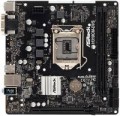HDMI output
The motherboard has its own
HDMI output.
Such an output is intended for transmitting video from an integrated graphics card (see above) or a processor with integrated graphics (we emphasize that it is impossible to output a signal from a discrete graphics card through the motherboard chipset). As for HDMI specifically, it is a combined digital video/audio interface specifically designed to work with HD resolutions and multi-channel audio. Today it is the most common of these interfaces, HDMI support is almost mandatory for video devices that are compatible with HD standards.
The specific capabilities of HDMI vary by version (see below for more details), but in general they are quite impressive — even in the earliest (current today) HDMI v.1.4, the maximum resolution is 4K, and in newer standards it reaches 10K. So in motherboards, the quality of the video transmitted through such an output is often limited not by the interface capabilities, but by the graphics performance of the system.
HDMI version
HDMI connector version (see above) installed in the motherboard.
— v.1.4. The earliest of the standards found nowadays, which appeared back in 2009. Supports resolutions up to 4096x2160 inclusive and allows you to play Full HD video with a frame rate of up to 120 fps — this is enough even for 3D playback.
— v.1.4b. A modified version of v.1.4 described above, which introduced a number of minor updates and improvements — in particular, support for two additional 3D formats.
— v.2.0. Also known as HDMI UHD, this version introduced full 4K support, with frame rates up to 60 fps, as well as the ability to work with 21:9 ultra-widescreen video. In addition, thanks to the increased bandwidth, the number of simultaneously reproduced audio channels has grown to 32, and audio streams to 4. And in the v.2.0a improvement, HDR support has also been added to all this.
— v.2.1. Another name is HDMI Ultra High Speed. Compared to the previous version, the interface bandwidth has really increased significantly — it is enough to transmit video at resolutions up to 10K at 120 frames per second, as well as to work with the extended BT.2020 colour space (the latter may be useful for some professional tasks). HDMI Ultra High Speed cables are required to use the full capabilities of HDMI v2.1, but older standard features are available with regular cables.

